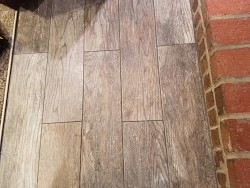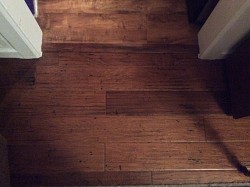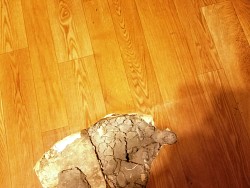New Wood Floor Finishes You Haven't Seen Before
 When people think of hardwood floors, many associations come to mind. These can range from fond childhood memories of lying on the living room hardwood at Grandma’s to an exasperated homeowner dealing with a cupped or poorly installed mess. Hardwood flooring has been around for well over a century, and believe it or not, some of the first floors are still in use today. The wood floor finishes available nowadays would boggle the minds of the turn-of-the-century carpenters who installed some of these ancient floors.
When people think of hardwood floors, many associations come to mind. These can range from fond childhood memories of lying on the living room hardwood at Grandma’s to an exasperated homeowner dealing with a cupped or poorly installed mess. Hardwood flooring has been around for well over a century, and believe it or not, some of the first floors are still in use today. The wood floor finishes available nowadays would boggle the minds of the turn-of-the-century carpenters who installed some of these ancient floors.
Surface Finishes
The largest category of wood floor finishes, surface finishes, form a durable and protective coating over the wood. Here, the finish durability varies based on the product being used, its application thickness, and the duration and condition of the curing process.
Historically, these finishes were natural varnishes and shellac. As modern chemistry advanced, so did the floor finish industry. Natural resins were replaced with alkyd resins, and now those have been upgraded to mostly polyurethane resins. The modern field-applied urethanes are then broken down into various types based on chemical composition or how they cure. The top 4 are:
1) Oil-modified urethane, a solvent-based product, is very common and relatively easy to apply. It dries or cures through the evaporation of the solvent and its reaction with oxygen in the air. The durability is considered very good and it is available in various sheens, from high gloss to matte. Being oil-based, its color tends to shift toward amber hues with age. Dry times can run up to 8 hours and change with humidity levels.
2) Water-based urethane cures and hardens through the evaporation of the water component. These water-based finishes typically have a subtler odor than their oil-based counterparts and tend to dry a bit faster. These finishes do not yellow with age like oil-based finishes. Some homeowners find this appealing; others consider their appearance “milky.” Often marketed as being greener than oil-based products, these finishes tend to command higher prices.
3) Moisture-cured urethanes are a bit more durable than both the oil-modified and water-based products. Moisture-cured urethanes are more difficult to apply and are oil-based, with satin or gloss sheens available. They are also formulated in non-yellowing and ambering types. Moisture-cured urethane has a stronger odor than the more common oil-modified products and is best applied by a professional flooring contractor.
4) Swedish finish or catalyzed urethanes are another of the oil-based products that are applied by pros. They are one of the most durable field-applied finishes, but they emit high volumes of VOCs during the drying and curing process. These finishes, comprising a base and hardener, have quick dry times. Even though these have some of the most VOCs of any flooring product, they are usually installed by professionals with the proper training and equipment to render them safe.
Prefinished Surface Options
Prefinished flooring has gained immense popularity in the past decade or two. Leading this group is the aluminum oxide finish. Those of you who are avid DIYers might recognize aluminum oxide as a type of sandpaper. The aluminum oxide used here is the same compound; it’s just processed differently.
In aluminum oxide wood floor finishes, the aluminum oxide is ground into a very fine powder -- not the coarse grains that are used in sandpaper. This powder is blended with the urethane and applied in many thin coats. The number of coats and the exact formulation of urethane dictate the overall durability of the finish. I have seen durability test data range by factors of 4 to 5 for various versions of aluminum oxide finishes. When considering this finish for your prefinished flooring product, feedback from other installations will ensure that the product you choose will stand the test of time.
Ceramic finishes are another new prefinished option and are very much like the aluminum oxide finishes, as they have ultra-fine particles of ceramic blended into the resins. These durable solids add excellent wear resistance and are economical options for many manufacturers.
Acrylic urethanes and acrylic impregnated woods are another prefinished option. These are similar to the polyurethanes in their resistance to wear, water and other spills. Some flooring manufacturers use UV-cured polyurethanes as their finish of choice; the high intensity UV light speeds the curing process and can result in faster and more efficient production.
These finishes that are factory applied are very durable, and unfortunately are not available for refinish work in the home. Drying ovens, UV chambers and production spray equipment are tools that flooring manufacturers use to get superior results. Field finish work is rarely sprayed and is therefore subject to minor imperfections.
Floor Finish vs. Furniture Finish
The finish applied to a floor differs from a finish you'd use on furniture in a few ways. Both may be polyurethane products, but floor finishes are often applied in thicker coats and with less precision.
As a furniture maker and floor refinisher, I often refer clients to the “double standard” of expectation. Floors should be viewed and accepted from eye level in standard lighting. If you crawl around on the floor and expect the finish to be as perfect and flawless as the finish on your dining room table, you will be disappointed. While it is possible to have them look alike, the needed time and effort for that level of preparation is cost prohibitive.
Penetrating Finishes
Smaller sets of finishes actually penetrate the structure of the wood and provide protection and add beauty. Wax has been used as a floor finish for about as long as floors have been around. It's often applied over basic penetrating oil or as a standalone finish. Tung and linseed oils have also been utilized as standard finishes for decades. Penetrating oil finishes are often combined with a topcoat of wax to add richness and depth to the wood’s grain and character.
When a wax or penetrating stain or oil is applied to wood, it soaks or is worked into the wood itself and the excess material is then removed. Waxes with solvent bases are very easy to apply and they dry quickly. These finishes are a little more work to maintain, but they are also one of the easiest to repair. The durability comes from the wood itself and varies by the characteristics of each species. Buffing an oil and wax finish can keep it looking like new, year after year, without the risk of chipping or flaking.
When I completed a large addition to my home, I used a traditional penetrating oil finish in my master bedroom. The hardwood flooring I chose was Jatoba, also know as Brazilian Cherry, which is significantly harder and more durable than oak. I prefer the look of satin and low-gloss floors, and linseed oil alone yields a subtle sheen that is timeless in its beauty. Linseed oil also imparts a pleasant smell during application and provides basic protection in a room where heavy traffic is minimized. The low cost of a linseed oil finish is also a nice benefit. Polyurethanes usually run $30-$40 a gallon; Swedish finishes $80-$100 a gallon; while linseed oil can easily be one-third of those costs.
Preserving Old Floors
Historic structures often have hardwood flooring installed which, over time, needs some type of maintenance. To maintain a degree of authenticity, refinishing this flooring with catalyzed modern polyurethane seems inappropriate. Bonita Mueller, a historical architect with the National Park Service, has this advice: “We have a lot of historic structures in the National Park Service which are open to the public. The areas that get a lot of wear are typically protected by some kind of sacrificial layer, whether that is carpeting, urethane, paste wax, etc. It depends on the significance and the use of the structure.
“I'd rather see projects start with a uniform surface that has been stripped and then either apply urethane or paste wax uniformly as the sacrificial layer. If you want to guard against flaking in the future, then paste wax would be the way to go -- or even paste wax on top of the new urethane. That might be overkill, however. Of course, the paste wax requires maintenance.”
Mueller urges people to think about the future when protecting the past. “Part of your solution needs to take into account the kind of maintenance you will have available on an ongoing basis. If it is practical and if this is appropriate to your final use, you might consider minimizing future wear by operational means once you have refinished your floor. You can request that people use booties that you slip over your feet before entering the structure.”
Kevin Stevens writes for networx.com.
Updated June 12, 2018.
Looking for a Pro? Call us (866) 441-6648

Flooring Average Costs
Flooring Contractors Experiences

Tile Floor Looks Like Wood, Stands Up To Life With Kids And Dogs

New Vinyl And Hardwood Flooring To Replace Water Damaged Floors



